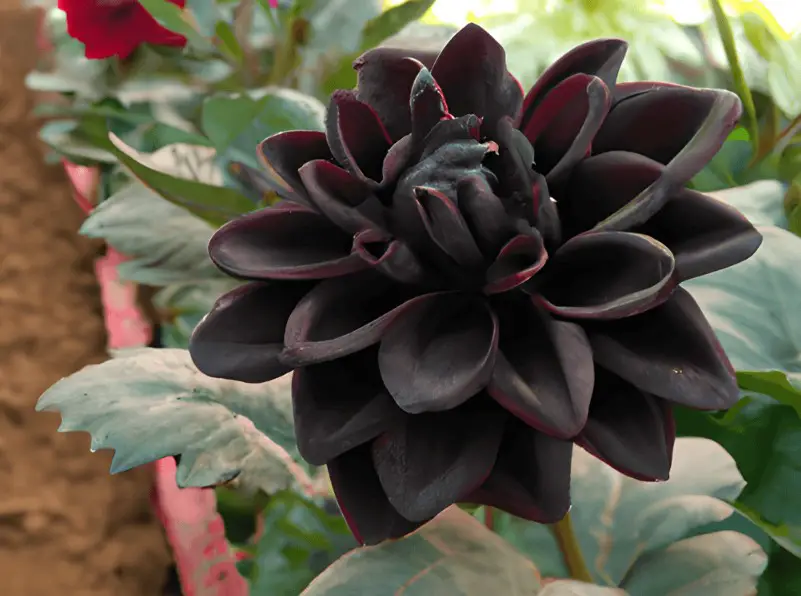Black Dahlia flowers, with their deep, intense colors ranging from maroon to almost black, bring a touch of mystery and elegance to any garden. Known for their velvety petals and captivating appearance, these blooms can thrive with the right care and attention.
If you’re interested in cultivating this stunning flower, this comprehensive guide will provide all the essential tips for Black Dahlia Flower care and help you grow these blooms successfully.
Why Choose Black Dahlia Flowers for Your Garden?

Black Dahlia Flowers are often selected for their unique color and exotic allure. Their nearly black shades create a rich, dramatic effect that’s perfect for gothic or sophisticated garden themes. Not only are they visually striking, but Black Dahlias also make wonderful additions to floral arrangements, adding depth and contrast to lighter-colored blooms.
Essential Requirements for Growing Black Dahlia Flowers
When it comes to growing Black Dahlia Flowers, understanding their key requirements is vital. These include soil quality, sunlight, water, and temperature. Let’s explore each of these factors in detail.
Soil Preparation for Black Dahlia Flowers
To ensure the optimal growth of Black Dahlias, choosing the right soil is essential. These flowers thrive in well-drained, nutrient-rich soil with a slightly acidic to neutral pH level (around 6.0-7.0). Preparing the soil in advance with organic matter, such as compost or manure, can improve its quality and provide the nutrients needed for the Dahlia’s robust blooms.
Sunlight and Temperature Needs
Black Dahlias love sunlight and perform best when exposed to 6-8 hours of direct sunlight daily. However, in regions with intense midday sun, a bit of afternoon shade can help prevent scorching. The ideal growing temperatures range between 60-70°F (15-21°C) during the day and a bit cooler at night.
Tip: Plant Black Dahlia tubers after the last frost date, when soil temperatures consistently reach 60°F (15°C) or above.
Watering Practices for Black Dahlia Flowers
Proper watering is crucial for the health of Black Dahlia Flowers. These plants prefer evenly moist soil, so deep watering once or twice a week is ideal, especially during dry periods. Avoid overwatering, as dahlias are prone to root rot if the soil becomes waterlogged.
Pro Tip: Water in the morning to allow moisture to evaporate throughout the day, reducing the risk of fungal diseases.
Step-by-Step Guide to Planting Black Dahlia Flowers
Planting Black Dahlia Flowers involves careful planning and execution. Follow these steps for successful planting and vibrant blooms.
Step 1: Prepare the Soil and Location
Choose a sunny, sheltered spot in your garden with good air circulation. Prepare the soil by loosening it and mixing in organic compost or manure.
Step 2: Planting Black Dahlia Tubers
Plant Black Dahlia tubers after the last frost, approximately 6 inches deep and 18-24 inches apart to allow enough space for growth. Place the tuber horizontally with the eye (the sprouting point) facing up.
Step 3: Cover and Water
Cover the tuber with soil and water it lightly. Avoid heavy watering initially; once the sprouts emerge, you can increase the water amount.
Caring for Black Dahlia Flowers Throughout the Growing Season
As your Black Dahlia Flowers begin to grow, consistent care is needed to maintain their health and vibrancy.
Fertilizing Black Dahlias
Dahlias are heavy feeders and will benefit from regular fertilization throughout the growing season. A balanced fertilizer high in potassium and phosphorus is ideal, while nitrogen should be used sparingly to prevent excessive foliage growth at the expense of flowers.
Best Practice: Apply a slow-release granular fertilizer every 4-6 weeks to ensure a steady supply of nutrients.
Mulching to Retain Moisture
Mulching around your Black Dahlia Flowers will help retain soil moisture, suppress weeds, and maintain a stable soil temperature. Apply a 2-3 inch layer of organic mulch, like straw or shredded leaves, around the plants, but avoid direct contact with the stems to prevent rot.
Supporting and Staking Black Dahlia Flowers
Tall Black Dahlia varieties may require support to prevent the stems from bending or breaking. Use stakes or plant cages to support the stems, especially in areas prone to wind.
Tip: Install stakes early to avoid damaging the roots once the plants are established.
Deadheading for Continuous Blooms
Deadheading—or removing spent blooms—encourages the plant to produce more flowers throughout the season. Regular deadheading will keep your Black Dahlia Flowers looking fresh and vibrant, extending their blooming period well into the fall.
Preventing Common Black Dahlia Pests and Diseases
Like any garden plant, Black Dahlias are susceptible to pests and diseases. Knowing how to identify and prevent common issues will help keep your plants healthy.
Pests to Watch Out For
Black Dahlia Flowers are prone to attacks from pests such as aphids, spider mites, and slugs. These pests can damage foliage and flowers if left unchecked.
- Aphids: Small, soft-bodied insects that feed on plant sap, often causing leaves to curl.
- Spider Mites: Tiny, spider-like creatures that cause speckled leaves and webbing.
- Slugs and Snails: These pests leave ragged holes in leaves, especially in damp conditions.
Solution: Use insecticidal soap or neem oil spray to deter pests and hand-pick slugs and snails.
Diseases and How to Prevent Them
Common diseases affecting Black Dahlia Flowers include powdery mildew, botrytis, and root rot. Preventing diseases starts with proper watering techniques and good garden hygiene.
- Powdery Mildew: Appears as a white powdery coating on leaves; avoid overhead watering and ensure good air circulation.
- Botrytis (Gray Mold): Causes wilting and grayish mold on flowers and leaves; remove and destroy affected parts.
- Root Rot: Caused by overwatering or poor drainage; avoid waterlogged soil.
Tip: Always clean your garden tools to prevent the spread of disease.
Propagating Black Dahlia Flowers
Propagating Black Dahlia Flowers can be a rewarding way to expand your garden. There are two primary methods: tuber division and cuttings.
Tuber Division
The easiest way to propagate dahlias is by dividing the tubers. In early spring, before planting, divide large tubers, ensuring each division has an “eye” or growth bud.
Cuttings
For a more challenging approach, you can take cuttings from the Dahlia’s shoots in spring. Place the cutting in a pot with moist, well-draining soil and keep it in a warm, sunny location until it establishes roots.
Overwintering Black Dahlia Flowers
In colder climates, Black Dahlia Flowers need extra care to survive the winter months. Here’s how to protect your dahlias during winter:
- Dig Up the Tubers: After the first frost, carefully dig up the tubers, leaving some soil around the roots to protect them.
- Dry and Store: Allow the tubers to dry for a few days, then store them in a cool, dry place in peat moss or sawdust to prevent rotting.
- Replant in Spring: When the frost has passed, replant the tubers to start the growing cycle again.
Pro Tip: Check stored tubers every few weeks and mist lightly if they appear too dry.
Creative Landscaping Ideas with Black Dahlia Flowers
Black Dahlia Flowers can enhance any garden with their unique and dramatic appearance. Consider these ideas to make the most of your Black Dahlias:
- Dark-Themed Gardens: Pair Black Dahlias with other dark-hued plants for a bold, gothic-inspired garden.
- Contrast with Light Colors: Combine Black Dahlias with light or pastel-colored flowers for a striking contrast.
- Use in Borders: Plant tall varieties in the back of a garden bed or along a fence for height and structure.
Frequently Asked Questions (FAQ) about Black Dahlia Flower Care
How Often Should I Water Black Dahlia Flowers?
Water Black Dahlias deeply once or twice a week, ensuring the soil stays evenly moist without becoming soggy. Avoid overhead watering to prevent diseases.
When is the Best Time to Plant Black Dahlia Flowers?
The best time to plant Black Dahlia Flowers is in late spring, after the last frost, when soil temperatures consistently reach 60°F (15°C) or higher.
How Can I Get My Black Dahlia Flowers to Bloom Longer?
Deadhead spent blooms regularly and apply a balanced fertilizer to encourage continuous blooming throughout the season.
Can Black Dahlia Flowers Grow in Containers?
Yes, Black Dahlia Flowers can thrive in containers. Ensure the pot has adequate drainage and is large enough to accommodate the plant’s growth. Use high-quality, well-draining potting mix and place the container in full sun.
Conclusion
Black Dahlia Flowers are a captivating addition to any garden, offering rich colors and a unique aesthetic. By understanding their requirements and following these care tips, you’ll enjoy vibrant, healthy blooms that add mystery and elegance to your outdoor space. With consistent care, pest prevention, and seasonal maintenance, you can make the most of your Black Dahlia Flowers and enhance your garden’s overall beauty.






